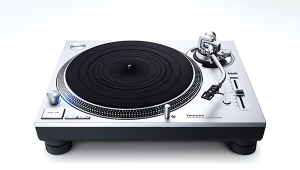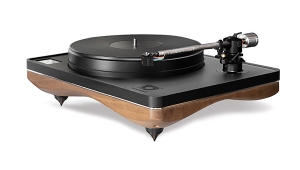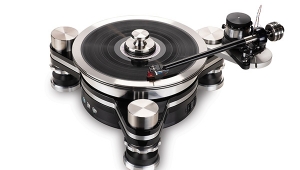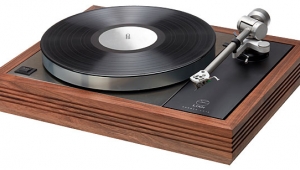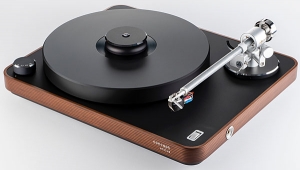| Columns Retired Columns & Blogs |
Oracle Delphi turntable MF & Delphi Mk.V part 2
Over the years, the original Oracle has been modified and improved many times, but the basic design remains unchanged—so much so that the subchassis of the original Oracle will fit perfectly on the spring towers of the latest version. Whereas the original Oracle featured an AC motor, the Delphi that I owned used a square, black, "Hall effect" DC drive system. Oracle built 1500 of these. On the Delphi Mk.II, Oracle substituted a round Pabst motor similar to what ReVox used as a capstan drive on its famous A-77 open-reel tape deck. A few thousand Mk.IIs were built. Between 1986 and the demise of the original Oracle company in 1994, another 6000 Mk.IIIs and Mk.IVs were built. Oracle also built much smaller quantities of the bigger, more expensive Premiere and the smaller Alexandria and Paris models.
Oracle Delphi Mk.V: Since the Oracle's basic design hasn't changed, neither have the dimensions; the Mk.V comes cradled in the same styrofoam insert as my original Delphi. Watching Riendeau unbox the familiar packaging unleashed a rush of dizzying audiophilic nostalgia. (Okay, it's pathetic.) The glorious sound of my first top-shelf 'table charged my memory banks—as did a series of lifelike recollections of activities conducted in close proximity to that Oracle, which are best described in an infamous Ian Drury song and an Eric Bogosian play of the same name.
The packaging may have been an exercise in nostalgia, but as Riendeau set up the new Oracle and explained the many improvements made to the design, it became obvious to me that the new 'table was grounded in the future of analog, not the past. The fit'n'finish of the Mk.V—the machining—is far superior to that of the Oracle I owned, and up there with the best the world has to offer (at least that I've seen).
The Mk.V consists of an acrylic base containing the motor and electronic drive components, three spring-suspension towers, and a subchassis upon which are mounted the bearing/platter assembly and the arm. The subchassis fits over the three towers, and its weight decompresses the three springs. As any Linny knows, setting up a spring suspension can be a royal pain. If you don't get the springs balanced so the subchassis moves as one, you get a rocking motion that blurs and confuses the sound. Oracle has always supplied color-coded springs of different stiffnesses to deal with the different loads seen by the three towers, due to the asymmetrical mounting of the arm.
The Mk.V's 3 lb subchassis counterweight, placed opposite the armboard area, increases the subchassis' lateral stability and makes tuning the subsonic suspension much more easy and accurate. The towers themselves feature seven mechanical filters to isolate the record/stylus interface from external vibrations, including concave feet, Delrin pillars, rubber bushings, and dampers of Sorbothane and felt.
The drive system consists of a new German Berger Lahr 8V AC motor driven by a dual-current electronics module that supplies higher torque at startup and drops down for smoother performance once the correct speed has been achieved. The Mk.V's electronics have been neatly integrated into the subchassis. Long aluminum fingers extend from the module to the front of the 'table, allowing for instant "on" at the desired speed.
The Mk.V comes with a standard outboard power supply and an optional "Turbo" line conditioner ($500). The 8-lb aluminum platter with integral hard acrylic mat is driven by a flat molded belt riding on an inner rim. (The rubber "wave trap" rim found on older Oracles is no more.) The gold-plated motor pulley is crowned (convex) for maximum contact area and minimum adhesion. The integral screw-on clamp has been upgraded with the inclusion of a Delrin bushing and an O-ring, for lower noise transmission.
Finally, a brand-new bearing does away with the standard dual-bushing interface. Instead, the Mk.V uses six precisely surfaced nylon setscrews; Agence Commerciale Inc. claims these offer the lowest noise and highest level of rotational accuracy "ever achieved." ACI also claims the bearing system is maintenance- and adjustment-free, and will perform "flawlessly for a lifetime," which is more than any of us can claim.
Riendeau supplied me with a set of specs comparing the Mk.V's performance with the Mk.IV's. There were marked improvements all around: speed stability went from ±0.15% to ±0.047%, wow and flutter were almost halved, and rumble (unweighted) dropped from –67.5dB to –84dB.
Set-up: For obvious reasons, I asked Riendeau to drill an armboard for the new Graham 2.0, which had spent the previous five months or so on the TNT. It was also an opportunity to test the new company's machining accuracy. The Graham 2.0 doesn't feature the 1.5t's sliding base, so if the mounting base hole isn't drilled dead-on perfect, the Graham's overhang gauge is rendered useless, and any premounted cartridges have to be realigned using an external gauge. Fortunately, the round aluminum armboard Riendeau unpacked was dead-on accurate, so all three Graham armwands I had on hand could be used as-is.
It took Riendeau no time at all to set up the 'table, but I suspect that was partly due to his having adjusted the springs before he showed up. Once the Graham 2.0 was mounted, a few minor tweaks got the three suspension towers bouncing as one (suggestive, no?), and at a very low frequency—which is what you want. If you buy an Oracle and you're starting from scratch, I'm sure it will take you more time.
The Delphi Mk.V sat on a Symposium Acoustics isolation board—a really terrific upgrade to any Target stand wooden shelf. Had we had more time, I would have cleared the Vibraplane; but even on the 1/15th-the-price Symposium board, the Oracle performed brilliantly using the Grado Reference cartridge ($1200)/Graham 2.0 combo.
The Sound of the Mk.V: We had a few hours to listen, and since Jacques refused to nail down his musical preferences, I hit him with all kinds of stuff. We compared Classic's reissue of Reiner's Also sprach Zarathustra (LSC-1806) with the original shaded dog. (Classic shouldn't have started with this one—the original is magic, the reissue merely good.) We listened to some Miles Davis, to the original and Classic reissue of Sonny Rollins' The Bridge (here Classic nails it to perfection), some show music, and some rock. I played an original British pressing of the Small Faces' Ogden's Nut Gone Flake—Riendeau hated it, but it told me a great deal about the 'table's low-bass performance.
I also played him Belafonte at Carnegie Hall, another Classic reissue. (Why all the Classics? I dunno, it just worked out that way.) We compared the original pressing with both the regular reissue and a special 45rpm edition handed out to a few lucky reviewers. Riendeau couldn't get enough of that 45rpm pressing, and I don't blame him. While the regular issue was wonderful, the faster version was scary—it brought the event to life before our ears in a way the 331/3 version only hinted at. We also played the Classic gold CD on a very fine player. HA HA HA HA HA!
It would be foolish indeed for me to compare the Mk.V to my Delphi, which I haven't heard in probably seven years. So I won't. But the new Delphi continued the Oracle tradition of open, airy, relaxed sound; of rich, seductive midrange; and an honest, "giving" bloom in the midbass—that much I do remember about my old 'table. The new Oracle offered outstanding image focus and stability, and a very quiet ride—a very low noise floor combined with finely scaled dynamic gradations. The 'table's high-frequency performance was smooth yet detailed, indicative of outstanding speed stability and effective energy transfer from the motor to the platter.
Spring suspensions, designed to isolate the playback system from outside vibrations, have gotten a bad rap of late because of their inherent setup difficulties and their potential instability. Few records are pressed with truly concentric grooves—the arm usually ends up moving back and forth laterally, which can set a sprung subchassis into a disastrous rocking motion. If the motor is mounted to the unsuspended plinth, the rocking subchassis causes shifts in belt tension and thus in speed accuracy. This speed variation usually manifests itself sonically as brightness, hardness, and grain.
The Oracle's design places the center of gravity below the potential spring pivot points; coupled with the Delrin rods that help restrict lateral motion, and the damping built into the towers, this design minimizes if not eliminates that problem. The Delphi Mk.V's suspension seems to combine outstanding isolation with high stability. I say "seems" because I haven't yet spent enough time with the 'table to thoroughly check out all operating parameters, but I can tell you one thing: the Oracle more than passed the stylus-in-the-groove, platter-not-spinning thump test I described in my November '97 review of the Clearaudio 'table. There was almost dead silence—I think I could have thwacked the Oracle's plinth with a hammer and I wouldn't have heard it. I still don't recommend mounting a linear-tracking arm on the Delphi as I did back when, but if you do, I think you'll find the new 'table somewhat more stable.
If the new Delphi Mk.V gave any ground to the TNT, it might have been in terms of extension and control in the very deep bass. I say "might" because I've been listening to the VPI sitting on the ridiculously fabulous $5000 Vibraplane support. Unless and until I put the Delphi on the Vibraplane, the comparison is totally unfair.
What is totally fair is the Delphi Mk.V's price: $2775 for what is probably the most visually elegant turntable in the world—and built, from what I saw and felt, to a new, higher standard of excellence. Add $550 for the Turbo power supply (if you order it when you buy the 'table you receive a $100 credit). Dustcover and hinges are optional—and I don't recommend them. Drilled armboards are extra too. There's probably room for sonic improvement in the armboard, a two-piece aluminum sandwich bolted to a ring cut out of the subchassis. The design can't be the last word in energy dissipation and control. Perhaps a slathering of elastomer dressing between the slices would help.
Help for the needy 10,000: Okay, it was cruel for me to leave this for last, but I wanted to make sure you read everything: Yes, if you have an older Oracle—and I can't believe anyone threw theirs away—some parts are still available. More important, your 'table can be upgraded to current specs. Unfortunately, when the original Oracle company was shut down, many parts were heaved, but since much of the design hasn't changed, some critical parts are once again available. If your spring seats have cracked, for example, new ones are available. But motors for the Mk.I, II, and III aren't.
Better news: a series of upgrades can be had at very reasonable cost. For $1265 you get the new brushed-aluminum drive module, including the motor and electronics, new base, power supply, drive belt, oil, and necessary tools. If you have a really old Oracle—pre-Mk.II—the subchassis must be machined to make room for the motor housing. Add $85.
Mk.III and IV Delphis after serial number 8135, and Mk.V editions prior to 9990, can be retrofitted with the new Delrin suspension pillars for $79 for three, plus $35 for the tool. You can add the new six-point bearing to your Mk.IV for an additional $325 (add $100 for subchassis machining work to older models). The 3-lb subchassis counterweight will set you back an additional $95, as will the acrylic hard mat.
So let's say you have a Delphi like my old one: $1265 for the new drive, etc., plus $85 for machining of the subchassis. You can't add the Delrin pillars, but you can add the new bearing for $425 (includes $100 for the machining), and you can have the subchassis and acrylic mat for another $190. So for about $2000 you can have 90% of a brand-new Oracle Mk.V. I think at that rate you're better off selling your original Delphi and buying a new one, but beyond that model, if you own a more recent Oracle (of if you can get a used one cheap), here's your opportunity to upgrade to the Mk.V. From what I saw and heard, it's probably a worthwhile investment.
Jacques Riendeau took great pains to make clear to me that, while the Oracle turntable is back (in 12 countries so far, and growing), Oracle the company is gone—if you have a beef with them, forget it! But if you're interested in a new Oracle or in upgrading your older model, he's your man.—Michael Fremer
- Log in or register to post comments
